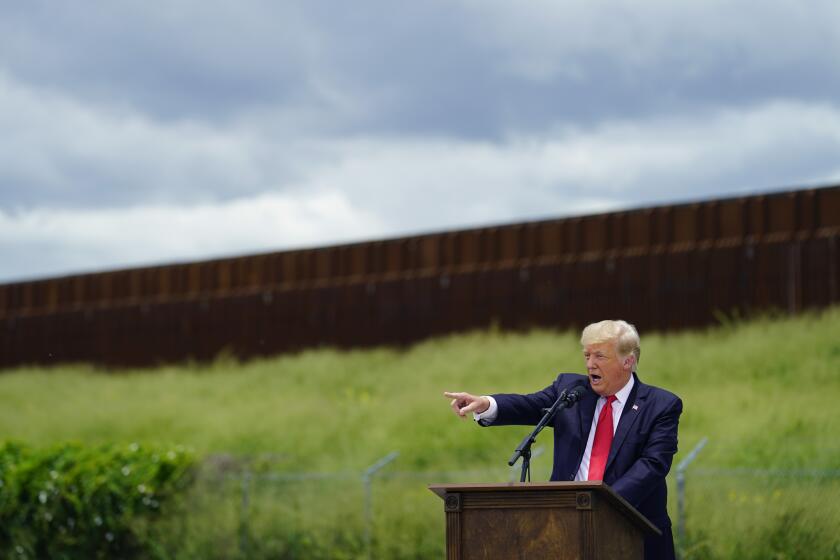Economy Shows Growth Spurt; Inflation Lags
WASHINGTON â The nationâs economy grew rapidly during the final three months of last year while inflation remained low, the government reported Friday, erasing fears that economic growth may finally be waning after six solid years.
Commerce Department figures showed that the gross domestic product--the total output of goods and services that the nation produces--grew at an unusually strong annual rate of 4.7% during the period after adjustment for inflation, up from a 2.1% annual rate the previous three months.
At the same time, the departmentâs broadest price index showed that inflation slowed to a scant 1.8% annual rate during the fourth quarter--down from a 2% annual rate during the July-through-September period--despite the end-of-year speedup in economic growth.
The Clinton administration touted the new figures as evidence of continued prosperity. Vice President Al Gore told reporters at the White House that the report showed the presidentâs economic policy âis working spectacularly well.â
However, analysts cautioned that almost half the robust fourth-quarter growth rate stemmed from an unusually large jump in the sale of high-value exports, such as aircraft, that even White House officials conceded is unlikely to be matched in 1997.
âSome of it really is a one-shot affair,â said Alicia Munnell, a member of the presidentâs Council of Economic Advisors. She predicted that the overall economy would grow moderately through the rest of 1997, without any immediate risk of overheating.
Private economists took much the same tack. Analysts said that despite the rapid fourth-quarter growth, they still expected the Federal Reserve Board to leave interest rates unchanged at a key strategy session next week. The Fed is poised to raise interest rates if inflation intensifies.
The nationâs financial markets posted a mixed reaction to the new figures. The stock market see-sawed, with the Dow Jones industrial average ending the day down a modest 10.77 points.
The slowdown during the previous quarter--when the growth-rate downshifted to a 2.1% annual rate, from a 4.7% pace in the second quarter of 1996--had raised fears that the nationâs economic growth might be waning.
Then-Republican presidential candidate Bob Dole, campaigning in Tennessee on the day those figures were released, complained that the economy might be slipping into a ârealâ slowdown. âIf this is a recovery, I can hardly wait for the recession,â he said sardonically.
But Fridayâs report showed that consumer spending, which had slowed sharply during the July-through-September period, rebounded smartly last quarter, surging at a 3.4% annual rate and ultimately accounting for fully half the economyâs total fourth-quarter growth.
As a result of the bounce-back, the Council of Economic Advisorsâ Munnell told reporters that âwe really look to the consumerâ to provide âa major source of strengthâ to sustain the economyâs growth in 1997.
Private economists were similarly upbeat, though not quite as ebullient. Cheryl R. Katz, senior economist at Merrill Lynch & Co., said she still expects the economy to grow by a moderate 2% to 2.5% for 1997--about the maximum that can be sustained without rekindling inflation.
The economy grew at a 2.5% annual rate during all of 1996, the Commerce Department said, up from a flat 2% in 1995--the slowest growth since the 1990-91 recession. The inflation rate for 1996 was 2.1%, down from 2.4% the previous year.
Economists were at a loss to explain why consumer spending and exports had fallen off so sharply during the third quarter of last year or why they rebounded during the October-through-December period.
Cynthia Latta, an analyst for DRI/McGraw-Hill, a Cambridge, Mass., economic forecasting firm, said the two quarters should be taken together to obtain a clear perspective. âThereâs no reason to think weâre at the start of a boom,â she said.
Indeed, along with the rebound in consumer spending and exports, Fridayâs report also showed some adverse developments:
* The overhang of unsold goods that has been building up in business inventories continued to expand sharply, a factor analysts said is likely to retard the economyâs growth this year if companies decide to slow their output until the excess is worked off.
* Business investment, which has helped hold down inflation by ensuring that companies have up-to-date production facilities, slowed sharply over the quarter, rising at only a 4.2% annual rate, down from a heady 17.5% pace between July and September.
* Residential construction, which also had fueled economic growth earlier in the recovery, fell for a second straight quarter, dipping at an annual rate of 1.3%, after dropping at a 5.2% pace during the July-through-September quarter.
(BEGIN TEXT OF INFOBOX / INFOGRAPHIC)
The Yardsticks
President Clinton says new economic figures show his policies are working. Private economists caution that the fourth-quarter growth is tied to a surge in exports that wonât be sustained.
OUTPUT
4.7%, 4th quarter
* Quarterly growth (on an annual basis) has not exceeded 4.7% since 1994.
****
INFLATION
1.8%, 4th quarter
* The broadest gauge of inflation has not been this low since 1993.
Source: U.S. Dept. of Commerce
More to Read
Get the L.A. Times Politics newsletter
Deeply reported insights into legislation, politics and policy from Sacramento, Washington and beyond. In your inbox three times per week.
You may occasionally receive promotional content from the Los Angeles Times.










